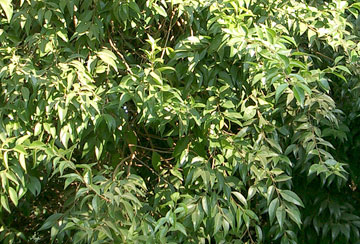Salinity Management Guide

Xylosma congestum (shiny xylosma)
Determining a factor for landscape plants other than turfgrasses, part 1: Research-based approach
Two different approaches are available to derive a plant adjustment factor (KL) for landscape plants other than turfgrasses. One is based on scientific research thus far conducted. The other is based on the observations of horticulturists. In this section we outline the research-based approach, leaving description of the observation-based approach for a later section.
Scientists have conducted research to determine the water needed by various species of trees, shrubs, vines, and ground covers. Data are available thus far for a limited number of species. A sample of the findings to date is available in Table 2. You may be able to assign KL for the plants in your landscape directly by consulting this table.
Example:
You need to assign KL for the shiny xylosma in your landscape.
- Referring to Table 2, you find that this species has been determined to have KL of between 0.18 and 0.36, based on research.
- You assign a value of KL within that range.
If your landscape includes plants not shown in Table 2, search the literature available on the Internet to find out whether recent studies have provided the information you are seeking. Research to determine values of KL is ongoing, so new data may become available every few years. If your search seems not to yield the data you need, you can approximate the number as outlined in the following paragraph.
Thus far, findings show that a number of species of landscape plants survive and sustain an acceptable aesthetic appearance and function when irrigated within a range of 0.18 to 0.80 of the reference evapotranspiration (ET0). If the water needed by the species in your landscape has yet to be researched, it is recommended that you initially assign a KL of 0.5 and then increase or decrease that in increments of 0.1 as indicated by subsequent routine monitoring of the landscape.
Example:
You need to assign a value of KL to the Mexican evening primrose in your landscape.
- You find that research has yet to be conducted on this species.
- You initially assign it a KL of 0.5.
- Later, make note in the field of any adjustments subsequently indicated.
| « Previous page | Next page » |